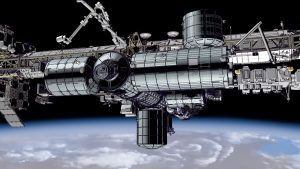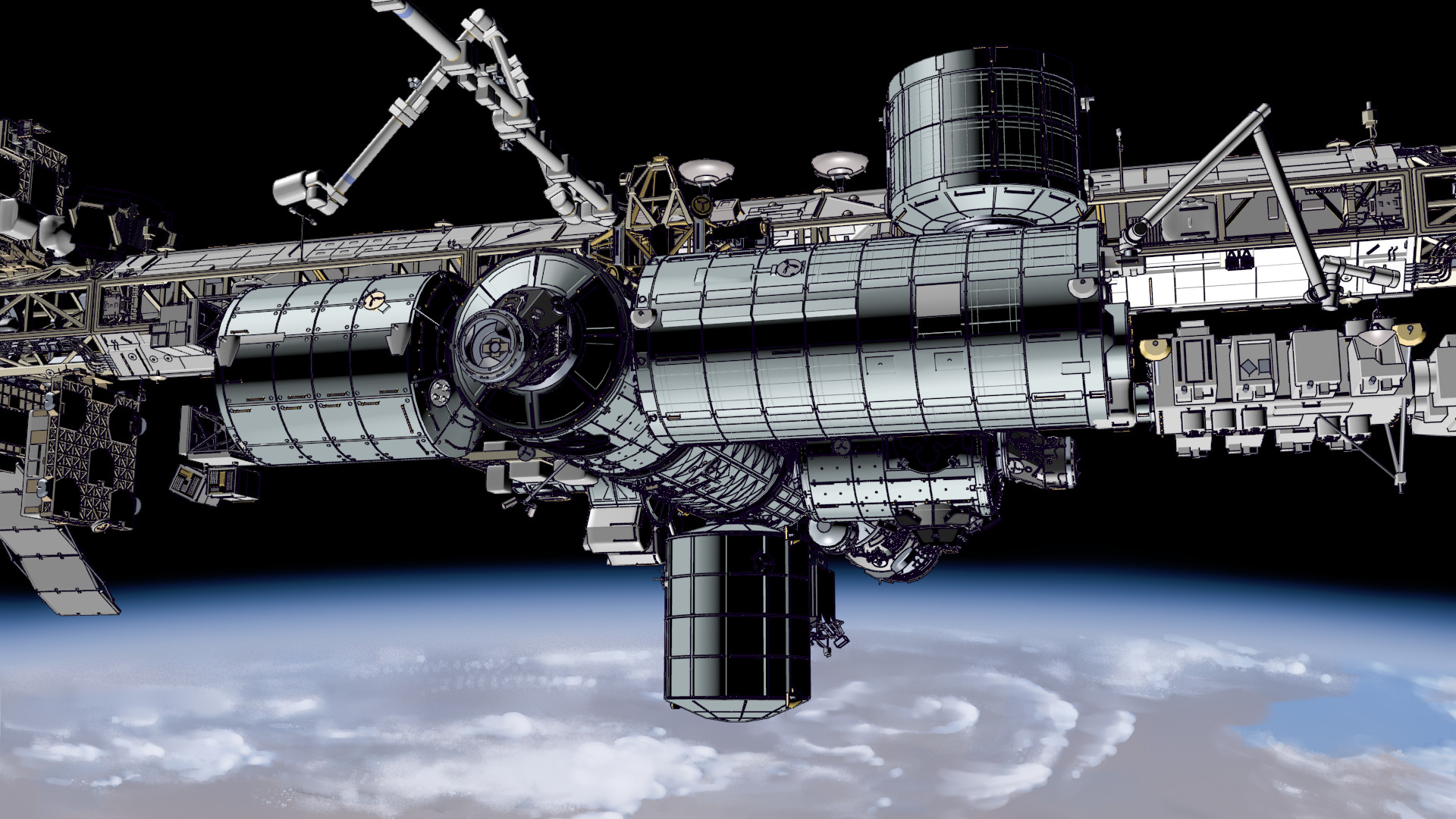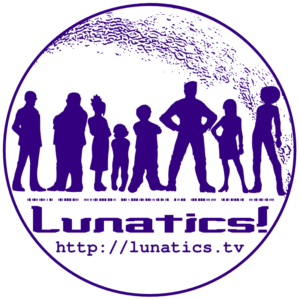Happy New Year! A lot has happened in the last few weeks, and we’re about to make some major changes on the “Lunatics!” project website. Progress continues on 3D assets for the series and for “No Children in Space”; and we’re making new promotional and fundraising plans. It’s time to shake things up, and we’re planning to do just that!

Wow. There’s been a lot going on with the “Lunatics!” project. Some of it was very good, and some of it was very bad. Overall, though, it’s clear that we’re going to be changing a lot of things.
Audiodrama “Earth” Completed
One of the most exciting developments of 2013 is that we finished our first complete story production — which is the audiodrama version of the episode “Earth”. This episode introduces the character “R. Allen Emerson”, a “meta-conceptual” artist who comes to the colony to observe, experience, and record a lunar eclipse as seen from the Moon (which means the Sun will go behind the Earth). At the same time, the colonists are struggling with their first real existential threat, because there’s a mysterious problem with some of the crops.
This drama is now available for download or streaming on our site. We will be offering this as the main attraction on an up-coming audio CD.
We’re really proud of this story and recording!
The Fire
On December 3rd, though, not long after we initially published “Earth” and launched an IndieGoGo campaign associated with it (to pre-sell the audio CDs and raise money for paying actors and if possible, 3D modelers), we had a large grass and building fire which did a great deal of damage to our main office facility — which is to say, my home office in the back of the building we call the “library”. Even more damage was done to our “shop” building, including completely destroying our main electrical box on the property. Then we almost immediately had an ice storm which made repairing the electrical system a real problem (and of course, we had no heat).
Needless to say, we were pretty busy working on that problem, and as a result, we completely neglected promoting the IndieGoGo campaign which just sat at zero until late in December, when we retired it (technically it’s still up, but I’ve removed all the rewards and marked it as “canceled”). We considered doing a new start on it in December (when it was down to 30 days), but decided that, with the time running out, it would be smarter to just cancel it and try again, perhaps with a different strategy.
The fire damaged, but did not destroy our main production computer. However, it appears that no data has been lost. I immediately backed up most of our project data by writing it out to Millenniata “DVD-M” archival disks. So we’re pretty safe on that front.
It was quite a wake-up call as to how much data had not yet been migrated to our Subversion server, though, and I have been working hard to bring the repository up to date. This is also necessary for us to begin serious work on set models.
Production Strategy Changes and Learning
This series will remain a free-culture project. But I’ve dismissed a lot of more conventional channels for film financing and support on the belief that they just won’t be compatible with our free-culture goals. That belief is largely untested, though, because I haven’t studied the conventional methods well enough. One of my first goals as producer this year (which I’ve already started on) is to become much more familiar with the world of independent film and animation and how other film projects get financed. Some may not work for us, some may work just fine, and some may work with a little adaptation.
We don’t need to reinvent every wheel!
I need to do a lot more research here, but it’s quite likely that we’ll be entering some of our work (starting with the audiodrama) into festivals or competitions of one kind or another. Getting recognition at that level would be a huge step forward in promoting the project.
I’m also considering some ancillary products we might produce from our assets and/or team that might make additional associations and improve awareness of our project.
I don’t want to get too specific before I’m fully committed, but I have several ideas that I’m pursuing:
- Presenting our free-software-based workflow through for-sale tie-in books or tutorials
- Advocating or educating about free-culture
- Making easily-understood educational materials for space and space technology (related to an earlier idea we had, called Rocket Science 101)
- Going more “transmedia” with stories in audio, text fiction, or web comic format
Many of these things could be done with almost no extra effort beyond what we’re already doing for the animated production. And of course this ties in with having something to sell through the storefront I proposed above.
Art and Style: More and Better
I’ve talked a lot about Lunatics from a perspective of free-culture advocacy, free-software demonstration, new business models, and even a little bit from the aspect of story (though I’ve tried not to drop “spoilers”). But we’re also trying to do some exciting things visually, and I’m going to be focusing more on the “non-photorealistic” rendering for Lunatics, and trying to get some more “final look” work out there.
I’ve not wanted to do too much of this kind of work yet, because we had few 3D assets to do it with, but that’s changing. This Spring, I’m going to work towards producing a series of “key stills” which will show final posed characters on final sets with the final “inked and shaded” look that I’m aiming for. I’ve found that for many people, this is the most interesting aspect of our project, and yet they don’t yet have a clear idea of what we’re talking about.
In some ways, the Soyuz launch demo backfired, because people didn’t like the way Georgiana looked. This was intended as a first pass for what the “final look” might have been. It was made without worrying too much that it could be clearly seen as CG, and maintaining an “economical style” –meaning a style I was sure we could keep up through a whole episode, was what I was aiming for.
However, looking back on it, I too have to agree that it could be improved a lot, and I’d like a more Freestyle/NPR look better. So, I’ve decided to go further in that direction. This is far more demanding on the hardware (we’re going to need that cluster to animate in this style), and requires quite a bit more work in the rendering process, but I think the results are worthwhile (like the ISS model I’ve illustrated this post with).
So, what I’m resolving is to put more effort into the graphical “look” of Lunatics, and I think this will make the project a lot more compelling — both for people seeing our project for the first time and also for the artists who are working on it.
Fixing the Project Website
Frankly, the project’s web presence has fallen very short of my intent.
The Old
We’re going to reduce our reliance on the Plone CMS. Plone is a powerful tool in the hands of professional maintainers, but is not so good “out of the box”, and I simply don’t have the time to make it do what I need. I’m not sure whether we’ll get rid of it completely or not.
This “production blog” or “project news” is based in Plone, and I have never been able to allow reader comments on it. It is possible to enable automated sign-up and commenting features, but the out-of-the-box Plone provides absolutely no support for managing spam bots. I tried turning on just the automated sign-up feature for about a week, and got something like 1200 fake users signed up on the site. Furthermore, the administrative interface only lets me delete them one at a time. Needless to say, that’s not happening. So we have this one-sided communication (although I do pay attention to responses on Facebook, Google+, Diaspora, and Twitter).
We were using a MediaWiki installation for pre-production assets. However, it doesn’t quite fit the task and we’ve actually found ourselves relying more on private emails, which means stuff gets misplaced, and also that it’s not very “open source”. OpenUpload was a useful package for receiving large files, but the interface is a little clunky, and it’s intended to be a general file-sharing tool, not a submissions system. Subversion and Trac work okay as far as they go, but they don’t fill all the project’s needs for storing digital assets, and trying to use them to store all the assets is failing for us. Again, we’ve slipped into passing lots of data around privately, which results in disorganization (and had the fire been more severe, we might have lost some of it).
We’ve tried to use some outside services. We got a good start with Kickstarter, but I don’t know if it’s going to be the best choice for us from now on. We tried IndieGoGo unsuccessfully, but I think that had more to do with our approach than with the site. The team behind Wreck-a-Movie seems to have abandoned it, which may be part of why it didn’t work out very well for us. And of course, we used the non-free Skype for teleconferencing, simply because most of the team had it installed already.
The New
So what are we going to migrate to?
A self-hosted WordPress blog as a solution for the production blog and possibly some of the CMS needs. I’m not certain whether we’ll migrate the main site fully to WordPress, or just the blog — it depends on how much flexibility it allows me.
We’re not getting rid of Subversion, Trac, or MediaWiki, as I still think they have applications. But we are adding a new package called Resource Space, which is a full, open-source “Digital Asset Management System“. If this doesn’t work as well as I think it will, we have other some other open source DAMS to try out. There’s a nice video intro to Resource Space, if you want to understand better what it’s useful for. In brief, a DAMS makes it a lot easier to track, organize, and locate digital assets (things like photos, sound recordings, video clips, 3D models, etc). This particular one has good web integration which means it’s perfect for our project.
Resource Space also provides through-the-web large file uploads, so it should replace Open Upload.
For voice and real-time visual collaboration, we have been considering “Big Blue Button“, which would provide the ability to do presentations, meetings, and whiteboard work online. Aside from the cast readings, where it is essential, this could really speed up our collaboration in other areas, like 3D modeling and animation, as compared with long email exchanges. Rather than burdening our server with this, we’ll probably use a hosting service.
We are also very likely going to open an online storefront, although this is a little risky. We have to at least have enough projected sales to cover the monthly fees on the storefront. One of the best is run by Amazon, mostly because of the ability to integrate into the Amazon Marketplace and be found by searches on the Amazon site. Of course, they charge for all of that, so it does have some significant overhead costs. We need to make sure we have products to sell before attempting it.
We may look into somewhat more specialized funding and collaboration sites targeted at independent film, like Seed and Spark, which I recently discovered.
I think it’s going to be an exciting year for us!
[NOTE 2025: The Social Media links are obsolete. But we’re now on the Fediverse via Pixelfed (project) and Misskey (Terry Hancock)]

